Overview
- Brief Narrative
- Tinnie, or pressed tin pincap badge owned by Frank Meissner, who served in the Czech Air Force from 1944-1945 for the Czech government in exile. It features the Czech coat-of-arms with the rampant split-tailed lion of Bohemia. At the age of 16, Frank left Trest, Czechoslovakia, in 1939 to avoid the increasingly harsh Nazi persecutions of Jews. He went to Denmark with Youth Aliyah to attend agricultural school. In fall 1943, when the Germans decided to deport all Jews from Denmark, Frank was smuggled on a fishing boat to Sweden. During his exile, he received weekly letters from his family, even after their deportation to Theresienstadt ghetto. The letters stopped in 1943. In the fall of 1944, Frank learned that his family had been sent to Auschwitz concentration camp. He joined the Czech army-in-exile in Great Britain. After the war ended in May 1945, Frank returned to Czechoslovakia searching for his family, but he found no survivors.
- Date
-
commemoration:
1944-1945
- Geography
-
issue:
Great Britain
- Credit Line
- United States Holocaust Memorial Museum Collection, Gift of Margit Meissner
- Contributor
-
Subject:
Frank Meissner
Subject: Margit Meissner
- Biography
-
Franz (Frank) Meissner was born on September 18, 1923, in Trest, Czechoslovakia to Norbert and Lotte. He had an older brother, Leo, and his paternal grandfather also lived with them. His father had owned a wooden shoe factory, but it closed during the economic crisis of 1929. His mother worked as a secretary at her brother’s machine factory to support the family. His father was the president of their synagogue and they went to synagogue every morning. The Jewish community in Trest was small, with only 64 members in 1930. There was no secondary school in Trest, so when Frank was 11 years old he attended school in a neighboring town. In 1937, he left school to apprentice at his uncle’s machine factory. That year he also joined Youth Aliyah, a Zionist youth group, and traveled to Prague to learn Hebrew and to develop a farm proposal for emigration to Palestine. Both brothers wished to emigrate from Czechoslovakia, with the entire family joining them later.
In October 1939, because of increasing persecution by the Germans, Youth Aliyah arranged the emigration from Czechoslovakia to Denmark of many members, including 16 year old Frank. Leo, still waiting to go to Palestine, chose to remain with their parents. Frank was strip searched at the border wehn he eft October 24. He and the other boys were sent to live and work on farms in Denmark. After an initial unpleasant placement, Frank stayed with the Nielsen family, where he was made to feel like part of the family and became involved with the Nielsen’s church. In 1941, he earned a scholarship to attend an agricultural high school in Denmark. Through these early years of the war, Frank received weekly letters from his family. In May of 1942, his family wrote that they were getting ready for their departure, although they do not know where they are going. They tell Frank that they are proud of him and that he should not worry about the family.
After graduating high school, Frank enrolled in the Agricultural College of the University of Copenhagen. In October 1943, he received a call from his landlady telling him not to return home because the Gestapo was looking for him. With the aid of a friend with connections to the underground resistance movement, Frank was smuggled on a fishing boat to Sweden, where he finished his education. While mail service to Europe temporarily improved, and Frank could occasionally send packages of food, he no longer received any letters in return. In September 1944, Frank went to England and was told that if he wanted refuge and a Czech passport, he had to volunteer for the Czech government in exile army. He served in the Royal Air Force in Scotland for the rest of the war. He intensified his efforts to find his family and learned that they had been deported to Theresienstadt. Around May or June 1945, Frank went back to Prague to search for them. A woman from their town wrote Frank that his family had not returned after the war and that after a year in Theresienstadt they had been sent to Auschwitz where they perished. In 1946, he was demobilized and returned to the University in Copenhagen, graduating in 1948 with a bachelor of science in agronomy. He returned to Czechoslovakia, but left six months after the Communist coup that February. He emigrated to the United States in January 1949. He attended Iowa State College and after receiving a masters in agronomy, transferred to the University of California, and 3 years later to Cornell where he earned his doctorate. In 1953, Frank married Margit Morawetz, originally from Austria. She had fled from Prague to France, eventually emigrating to the US in April 1941. 1953. Frank, age 67, died from cancer January 19, 1990, in Maryland.
Margit Morawetz was born February 26, 1922, in Innsbruck, Austria. Her parents were Gottlieb Morawetz and Lilly Tritsch. She had three older brothers, Paul, Felix, and Bruno. They ranged in age from 8 to 5 years older than Margit. The family was wealthy and assimilated. Margit's father came from an orthodox Jewish family of poor tenant farmers in Bohemia. He studied law in Vienna and worked as a bank director. Her mother came from an assimilated Jewish family in Vienna and was educated in England and France. When Margit was one year old, the family moved to Prague, Czechoslovakia, where her father taught on the law faculty of Charles University, in addition to working in finance. Margit and her brothers grew up speaking Czech, German, French, and English. Lilly was ambivalent about the family's Jewish identity and wanted to have the children baptized. Her husband would not allow it, and the children were never given any religious education. In 1932, Gottlieb died suddenly at age 52. Lilly was then 39. The two oldest brothers, Paul and Felix, went overseas. Bruno stayed in Prague and studied agriculture.
In 1938, when Nazi Germany annexed Austria, Lilly decided it was safer to take Margit, then 16, out of school and send her to Paris, where she lived with a French family and studied dressmaking. Lilly was visiting Margit in Paris later that year when Germany annexed part of Czechoslovakia. Lilly hurried back to Prague to sell their home and ship their possessions to Paris, but while she was still in Prague, Germany annexed the rest of Czechoslovakia. Both she and her son Bruno managed to escape to Paris, but had to leave everything behind. Because of his agricultural training, Bruno was allowed to go to England to work as a farmhand. During this period, Margit was baptized a Lutheran with her mother's encouragement, possibly with the thought that it would provide some protection. Even before that, however, their papers did not identify them as Jews, only as Austrian citizens. When the authorities were interested in them, it was only as alien refugees, not as Jews.
In September 1939, Germany invaded Poland and France declared war on Germany. Since Austria was now part of Germany, the French considered Austrian citizens enemy aliens. Lilly was deported to a detention camp in Gurs in southern France. Margit was ordered to report in to the Paris police on a regular basis. In May1940, Germany invaded France. As German forces approached Paris, Margit bought a bicycle and joined the exodus from Paris toward the south. She spent the night with other refugees in a school in Etampes. Early in the morning, she resumed her trip south, leaving the school two hours before it was hit by German bombs. In Orleans, she boarded a train to Salies-de-Bearn, close to Gurs and the border that had just been established between the German Occupied Zone and the Free Zone. Now that France had capitulated, people with Austrian citizenship were no longer enemy aliens, so Lilly was released and rejoined Margit. They hired a farmer to smuggle their bags across the boundary into the Free Zone, and crossed over unencumbered as if they were just going for a stroll. So as not to be identified as foreign nationals, they carried no identification papers with them, only food ration cards that they still had from Paris, to give the impression that they were residents of that city. They traveled to Marseilles and began the long process of obtaining exit visas from France and immigration visas to some other country. When their money ran low, they received financial aid from the American rescuer Varian Fry. They eventually obtained transit visas to Spain and Portugal and a visa to the Belgian Congo on the grounds that Margit's father had owned shares in a Congolese mining firm. France, however, would not grant them exit visas before their transit visas were due to expire, so Margit and her mother traveled by train to Cerbere and walked through the hills into Spain illegally. They were arrested by Spanish police and spent several days in jail until German friends who now lived in Barcelona obtained their release. Margit and her mother then traveled on to Lisbon, Portugal. Since many other refugees had arrived there without much clothing, Margit was able to earn money as a dressmaker. They contacted Margit's brother Felix, who was living in the United States. He facilitated their immigration and they arrived in America in April 1941.
In December 1941, Margit married Otmar Gyorgy, a G.I. and a friend of her brother Felix. After America's entry into World War II, she worked for the Office of War Information, making use of her knowledge of languages, which now included Spanish and Portuguese. After the war, Margit worked for the U.S. Army Assistance Program to German Youth Activities, re-educating former Hitler Youth in Furth, Germany. She and Otmar eventually divorced. In 1953, she married Frank Meissner, a Jewish Holocaust survivor from Czechoslovakia. They had 2 children. Frank, age 67, died of cancer in 1990.
Physical Details
- Classification
-
Military Insignia
- Category
-
Badges
- Object Type
-
Cap badges (military badges) (aat)
- Physical Description
- Shield-shaped black metal concave medal, possibly made of pressed tin, with an impressed image of a rampant split tailed Bohemian lion wearing a crown with extended claws and a Cross of Lorraine coat-of-arms on its chest. A cylindrical metal bar is soldered to the back with the ends twisted crosswise.
- Dimensions
- overall: Height: 1.125 inches (2.858 cm) | Width: 1.000 inches (2.54 cm) | Depth: 0.250 inches (0.635 cm)
- Materials
- overall : metal
Rights & Restrictions
- Conditions on Access
- No restrictions on access
- Conditions on Use
- No restrictions on use
Keywords & Subjects
- Topical Term
- Holocaust, Jewish (1939-1945)--Czechoslovakia--Personal narratives. Jewish refugees--Denmark--Biography. Jewish refugees--Great Britain--Biography. Jews--Czech Republic--Trest--History--20th century. World War, 1939-1945--Jews--Rescue--Denmark--Personal narratives. World War, 1939-1945--Participation, Jewish.
Administrative Notes
- Legal Status
- Permanent Collection
- Provenance
- The badge was donated to the United States Holocaust Memorial Museum in 2004 by Margit Meissner, the wife of Frank Meissner.
- Funding Note
- The cataloging of this artifact has been supported by a grant from the Conference on Jewish Material Claims Against Germany.
- Record last modified:
- 2023-08-31 14:42:47
- This page:
- https://collections.ushmm.org/search/catalog/irn522662
Download & Licensing
In-Person Research
- By Appointment
- Request 21 Days in Advance of Visit
- Plan a Research Visit
- Request to See This Object
Contact Us
Also in Frank Meissner collection
The collection consists of pins and medals, documents, correspondence, photographs, and a publication relating to the experiences of Frank Meissner before the Holocaust in Trest, Czechoslovakia, during the Holocaust when he emigrated to Scandinavia, and during and after the war in Great Britain when he served n the Czech Air Force for the Czech government in exile.
Date: 1939-1946
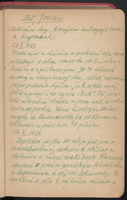
Frank Meissner papers
Document
The Frank Meissner papers contain material related to Frank Meissner, a student and member of a Zionist youth group who fled Czechoslovakia (Czech Republic) and attended school in Denmark, Sweden, and England during World War II. The majority of the papers are correspondence from Frank’s parents, living in his hometown of Třešť, and later Theresienstadt concentration camp. In addition, the collection includes school, financial, and identification documents. The photographs in the collection are of Frank and his family, the town of Třešť, and various moments during his time as a student in England and Denmark. Also included are two diaries and an autograph book. The majority of the Frank Meissner papers contain correspondence from Frank’s parents while he was away in Prague, and later at school in Denmark and Sweden. Both Charlotte and Norbert shared space on the letters, and often brother Leo would be included as well. The correspondence were written from Frank’s hometown of Třešt̕, and later Theresienstadt concentration camp, where his parents were imprisoned. Correspondence from after the war are mainly from friends. Other material in the collection are documents obtained by Frank throughout his time away at school. His school documents include report cards, certificates of adulthood, and various other papers from the Agricultural College of Sweden and the Veterinary and Agricultural College at the University of Copenhagen. The financial documents contains bank books and other concerns for Frank involving transferring currency to Sweden and a letter concerning his father’s estate after the war. The identification documents include a proof of residency and testimony to Frank’s attendance at school. Also included in the collection are photographs of Frank’s family and hometown, two personal diaries, an autograph book, and items Frank collected later in life such as photocopies of an article concerning the history of the Jews in Trest and a German picture book displaying images of various concentration camps.
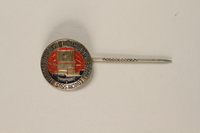
Enameled stickpin for the Studiosorum World Congress owned by a former Czech Jewish soldier
Object
Red and blue enameled stickpin acquired by Frank Meissner during the 1946 Studiosorum Congress in Prague. It features the logo design of a globe, open book, and flaming torch that symbolize youth's persisent quest for knowledge. This was the founding congress of the International Student Union created to promote democracy and education among students of all nations. At the age of 16, Frank left Trest, Czechoslovakia, in 1939 to avoid the increasingly harsh Nazi persecutions of Jews. He went to Denmark with Youth Aliyah to attend agricultural school. In fall 1943, when the Germans decided to deport all Jews from Denmark, Frank was smuggled on a fishing boat to Sweden. During his exile, he received weekly letters from his family, even after their deportation to Theresienstadt ghetto. The letters stopped in 1943. In the fall of 1944, Frank learned that his family had been sent to Auschwitz concentration camp. He joined the Czech army-in-exile in Great Britain. After the war ended in May 1945, Frank returned to Czechoslovakia searching for his family, but he found no survivors.
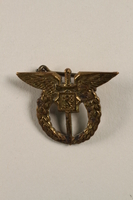
Czech Air Force pilot badge issued to a Jewish veteran
Object
Czech Air Force pilot badge issued to Frank Meissner for his service in the Czech Air Force from 1944-1945 for the Czech government in exile in Great Britain. It may be an observers badge. At the age of 16, Frank left Trest, Czechoslovakia, in 1939 to avoid the increasingly harsh Nazi persecutions of Jews. He went to Denmark with Youth Aliyah to attend agricultural school. In fall 1943, when the Germans decided to deport all Jews from Denmark, Frank was smuggled on a fishing boat to Sweden. During his exile, he received weekly letters from his family, even after their deportation to Theresienstadt ghetto. The letters stopped in 1943. In the fall of 1944, Frank learned that his family had been sent to Auschwitz concentration camp. He joined the Czech army-in-exile in Great Britain. After the war ended in May 1945, Frank returned to Czechoslovakia searching for his family, but he found no survivors.
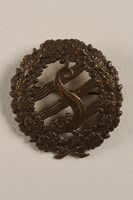
Wreath shaped badge owned by a Jewish veteran of the Air Force for the Czech government in exile
Object
Wreath shaped pin with a fish owned by Frank Meissner who served in the Czech Air Force from 1944-1945 for the Czech government in exile. At the age of 16, Frank left Trest, Czechoslovakia, in 1939 to avoid the increasingly harsh Nazi persecutions of Jews. He went to Denmark with Youth Aliyah to attend agricultural school. In fall 1943, when the Germans decided to deport all Jews from Denmark, Frank was smuggled on a fishing boat to Sweden. During his exile, he received weekly letters from his family, even after their deportation to Theresienstadt ghetto. The letters stopped in 1943. In the fall of 1944, Frank learned that his family had been sent to Auschwitz concentration camp. He joined the Czech army-in-exile in Great Britain. After the war ended in May 1945, Frank returned to Czechoslovakia searching for his family, but he found no survivors.
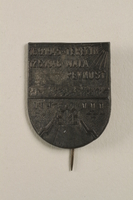
1st Anniversary commemorative pin for the victims of Theresienstadt acquired by a Czech Jewish survivor
Object
First anniversary commemorative pin for the May 12, 1945, liberation of Theresienstadt concentration camp acquired by Frank Meissner, whose family had been imprisoned in the ghetto/labor camp in Czechoslovakia. On September 16, 1945, there was a public ceremonial burial for 601 victims exhumed from six mass grave sites uncovered at the Small Fortress. From 1940-1945, the Small Fortress served as the prison at the Terezin camp. At the age of 16, Frank left Trest, Czechoslovakia, in 1939 to avoid the increasingly harsh Nazi persecutions of Jews. He went to Denmark with Youth Aliyah to attend agricultural school. In fall 1943, when the Germans decided to deport all Jews from Denmark, Frank was smuggled on a fishing boat to Sweden. During his exile, he received weekly letters from his family, even after their deportation to Theresienstadt ghetto. The letters stopped in 1943. In the fall of 1944, Frank learned that his family had been sent to Auschwitz concentration camp. He joined the Czech army-in-exile in Great Britain. After the war ended in May 1945, Frank returned to Czechoslovakia searching for his family, but he found no survivors.



